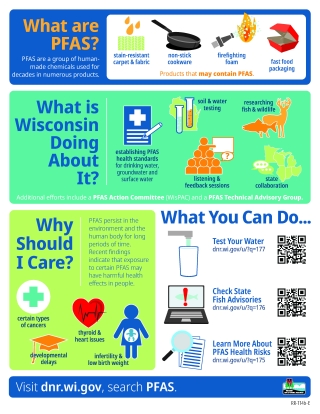PFAS Contamination in Dane County
PFAS contamination has been detected throughout Dane County in soil, municipal wells, private wells, surface water and groundwater.
Subscribe to updates about PFAS contamination in Wisconsin.
Submit a question, comment or concern about PFAS in Dane County.
Find a certified lab that can test drinking water for PFAS.
View an interactive map with data about PFAS contamination.
Search a database for sites with reported PFAS contamination.
Surface Water and Fish
Surface Water and Fish in the Yahara Chain of Lakes and Starkweather Creek
Starting in summer 2019, the DNR collected water chemistry and fish tissue samples from waterbodies near known or suspected PFAS contamination sites throughout Wisconsin as part of a water quality PFAS initiative.
Sample results for Starkweather Creek, which flows through east Madison and into Lake Monona, showed high concentrations of PFOA and PFOS. PFOS concentrations in Starkweather Creek and Lake Monona were above the DNR’s standard of 8.0 parts per trillion (ppt). There are known discharges of PFAS compounds to soil, surface water, stormwater and groundwater on the Dane County airport property where PFAS-containing firefighting foam products were used.
In response to these findings, the DNR took the following steps:
- Collected additional fish for PFAS analysis, including from Lake Monona near the Starkweather Creek outlet and throughout the Yahara chain of lakes. Elevated levels of PFOS were found in several species collected from lakes Monona, Waubesa and Kegonsa. The DNR and Wisconsin Department of Health Services (DHS) issued a fish consumption advisory for Starkweather Creek and most of the Yahara chain of lakes downstream to where the Yahara River meets the Rock River. Low levels of PFOS were found in fish sampled from lake Mendota and Wingra and no PFOS consumption advice has been issued for those lakes.
- Conducted surface water sampling to better define the extent of PFAS contamination. The DNR sampled water from lakes Mendota, Monona, Upper Mud, Waubesa and Kegonsa, as well as sections of the Yahara River downstream to the Rock River. Samples were also collected from Lake Wingra, Nine Springs Creek and Badfish Creek. Although PFAS concentration in Lake Mendota were very low, PFAS concentrations, particularly PFOS, in Lake Monona were elevated and remained elevated downstream throughout the Yahara River and chain of lakes. Lake Wingra, Nine Springs Creek and Badfish Creek had PFOS concentrations much lower than the Yahara chain of lakes.
- Continues to monitor surface water PFAS concentrations in Starkweather Creek and Lake Monona. Additional surface water sampling shows that PFAS concentrations in Starkweather Creek and Lake Monona remain elevated, with PFOS concentrations consistently greater than 8.0 ppt.
Health Information Related to Surface Waters
The DHS sent a letter to the DNR on Oct. 4, 2019, which assesses the health risks of PFAS in surface waters in the Starkweather Creek area.
The DHS has made the following recommendations in order to best protect people and pets from potential PFAS exposure in all surface waters, including Starkweather Creek.
- Avoid drinking or accidentally swallowing the water.
- Wash your hands after wading or playing in the water.
- Rinse pets after contact with water to avoid swallowing PFAS that may be on their fur.
Read more about the health impacts of PFAS.
PFAS Contamination in Private Wells
Drinking Water Sampling
Public Health Madison and Dane County (PHMDC) has funded some private well sampling in Dane County. Contact PHMDC about any available financial assistance for sampling a private well for PFAS.
Some residents of the Waubesa Beach area in Town of Dunn tested their private well water for PFAS and found contamination. They shared their results with the DNR, DHS and PHMDC.
Alternative Drinking Water
The DHS, DNR or PHMDC issue well-specific drinking water advisories for private wells that have levels of PFAS above DHS' recommended enforcement standards or the cumulative risk hazard index. Residences that have received a well-specific drinking water advisory from the DHS, the DNR or PHMDC can receive temporary emergency water from the DNR.
Eligible residents who choose to receive temporary emergency water from the DNR need to complete an Agreement for Requesting Temporary Emergency Water. Completed agreements can be emailed to Gwen.Saliares@wisconsin.gov or mailed to:
Wisconsin Department of Natural Resources
Gwen Saliares
625 East County Road Y, STE. 700
Oshkosh, WI 54901Temporary emergency water is delivered in five-gallon jugs. Those who are unable to lift five-gallon jugs should indicate on the agreement that they need a bottom-loading dispenser. Empty jugs will be exchanged for full jugs at the next delivery and should not be discarded or recycled.
Resources for Impacted Private Well Owners
The well compensation grant program provides funding to eligible landowners or renters to replace, reconstruct or treat contaminated private water supplies that serve a residence or provide water to livestock. To be eligible, family income may not exceed $65,000 for the prior calendar year. The grant program will pay 75% of eligible costs up to $16,000. The maximum grant possible is $12,000.
Health Information Related to Private Wells
The Wisconsin Department of Health Services (DHS) supports the DNR in assessing human health risks associated with PFAS contamination, including providing recommendations to reduce those risks.
For health-related questions, please email DHS at DHSEnvHealth@dhs.wisconsin.gov.
Learn more and access resources about the health effects from PFAS on the following websites.
- DHS: Per- and Polyfluroalkyl Substances (PFAS)
- Agency for Toxic Substances and Disease Registry (ATSDR): PFAS and Your Health

